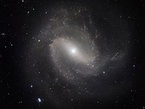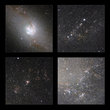Messier 83
Clear New View of a Classic Spiral
Messier 83 has been observed in the infrared part of the spectrum using HAWK-I [1], a powerful camera on ESO’s Very Large Telescope (VLT). When viewed in infrared light most of the obscuring dust that hides much of Messier 83 becomes transparent. The brightly lit gas around hot young stars in the spiral arms is also less prominent in infrared pictures. As a result much more of the structure of the galaxy and the vast hordes of its constituent stars can be seen. This clear view is important for astronomers looking for clusters of young stars, especially those hidden in dusty regions of the galaxy. Studying such star clusters was one of the main scientific goals of these observations [2]. When compared to earlier images, the acute vision of HAWK-I reveals far more stars within the galaxy.
The combination of the huge mirror of the VLT, the large field of view and great sensitivity of the camera, and the superb observing conditions at ESO’s Paranal Observatory makes HAWK-I one of the most powerful near-infrared imagers in the world. Astronomers are eagerly queuing up for the chance to use the camera, which began operation in 2007 (eso0736), and to get some of the best ground-based infrared images ever of the night sky.
Notes
[1] HAWK-I stands for High-Acuity Wide-field K-band Imager. More technical details about the camera can be found in an earlier press release (eso0736).
[2] The data used to prepare this image were acquired by a team led by Mark Gieles (University of Cambridge) and Yuri Beletsky (ESO). Mischa Schirmer (University of Bonn) performed the challenging data processing.
Source: ESO - European Southern Observatory
Messier 83
Clear New View of a Classic Spiral
Messier 83 has been observed in the infrared part of the spectrum using HAWK-I [1], a powerful camera on ESO’s Very Large Telescope (VLT). When viewed in infrared light most of the obscuring dust that hides much of Messier 83 becomes transparent. The brightly lit gas around hot young stars in the spiral arms is also less prominent in infrared pictures. As a result much more of the structure of the galaxy and the vast hordes of its constituent stars can be seen. This clear view is important for astronomers looking for clusters of young stars, especially those hidden in dusty regions of the galaxy. Studying such star clusters was one of the main scientific goals of these observations [2]. When compared to earlier images, the acute vision of HAWK-I reveals far more stars within the galaxy.
The combination of the huge mirror of the VLT, the large field of view and great sensitivity of the camera, and the superb observing conditions at ESO’s Paranal Observatory makes HAWK-I one of the most powerful near-infrared imagers in the world. Astronomers are eagerly queuing up for the chance to use the camera, which began operation in 2007 (eso0736), and to get some of the best ground-based infrared images ever of the night sky.
Notes
[1] HAWK-I stands for High-Acuity Wide-field K-band Imager. More technical details about the camera can be found in an earlier press release (eso0736).
[2] The data used to prepare this image were acquired by a team led by Mark Gieles (University of Cambridge) and Yuri Beletsky (ESO). Mischa Schirmer (University of Bonn) performed the challenging data processing.
Source: ESO - European Southern Observatory








